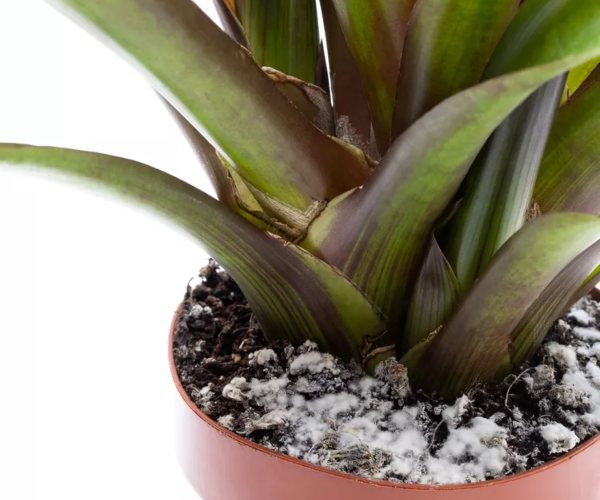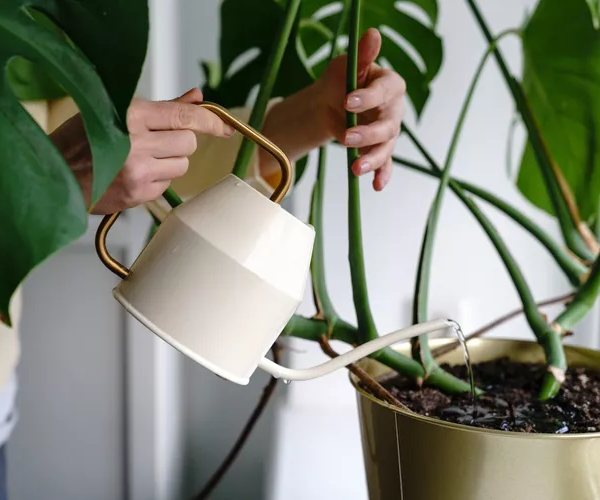Don’t let a fuzzy white layer on your houseplant’s soil send you into a panic. While it may look concerning, mold is often a harmless issue that can be easily resolved. This common houseplant problem can be caused by excess moisture or poor air circulation.
You can take a few simple steps to get rid of the mold and prevent it from returning. Start by carefully removing the top layer of soil, where the mold is most concentrated. Replant your plant in fresh, well-draining soil and adjust your watering schedule to allow the soil to dry out slightly between waterings. Additionally, ensure that your plant is placed in a location with good air circulation to help prevent future mold growth.
What Does Soil Mold Look Like?
Mold often manifests as fuzzy white patches, ranging from small to large, on the soil surface in your houseplants. It can also be seen growing from the drainage holes of the container. The presence of excessive mold almost always indicates that the soil is too wet.
Why Houseplant Soil Gets Moldy
While even the healthiest houseplant soils can experience some molding growth, excessive mold often indicates that the conditions you’re providing for your plant are not ideal. To prevent excessive mold growth, it’s important to be aware of the factors that contribute to its development.

Overwatering
Overwatering your plants can create ideal conditions for mold growth. Excess moisture in the soil provides a fertile environment for mold spores to flourish. This problem is particularly common during the colder months when the soil dries out more slowly.
Poor Drainage
When moisture is unable to drain effectively from the soil, creating consistently soggy conditions, it becomes an ideal breeding ground for mold spores. The constant presence of excess moisture provides the perfect environment for these spores to germinate and grow, leading to the formation of mold.
Contaminated Soil
Molding in potting soil can often be attributed to contaminated bags of potting soil or those that have been exposed to moisture and not stored properly. Contaminated soil may contain harmful pathogens or chemical residues that create favorable conditions for mold.
Additionally, moisture-exposed soil provides an ideal environment for mold spores to germinate and grow. To minimize the risk of mold growth, it is essential to purchase reputable brands of potting soil, inspect it for contaminants, store it properly, and use fresh soil.
Also, Read How Can I Ensure Healthy and Thriving Moonflowers in My Garden?
Is Moldy Soil Bad for Houseplants?
While moldy soil may be visually unappealing, it’s typically not harmful to houseplants. Saprophytic fungi, which feed on decaying matter, can be beneficial for the soil. However, excessive mold growth can compete with your plant for nutrients, hindering its growth.
The real concern with excessive mold is that it often signals underlying issues in your plant’s growing environment. Overwatering is a common culprit, leading to more serious problems like root rot and attracting pests such as fungus gnats.
How to Get Rid of Moldy Soil
These are some methods you can try to get rid of moldy soil:
- Scrape it Away: For minor molds on the soil surface, you can easily remove it by gently scraping it away. Once the soil has dried out, add a fresh layer of potting mix to the top. To prevent future growth, be cautious not to overwater your plant.
- Use a fungicide: Many gardeners believe that sprinkling cinnamon on the soil can help prevent molding. Another option is to use a mixture of baking soda and water. If these natural remedies don’t work, commercial soil fungicides can be effective.
- Replace the soil: When dealing with severely moldy soil that is overly wet and has poor drainage, repotting your plant might be the most effective solution. This involves removing the plant from its current container, carefully cleaning the roots, and repotting it in fresh, well-draining soil. This process can provide your plant with a clean start and help prevent future molding.
How to Prevent Molding in Soil?
Learn these tips to prevent your soil from molding and keeping them happy and healthy:

- Stop Overwatering: To prevent overwatering, which can lead to mold growth, test the soil moisture by sticking your finger into it. Water your plant only when the top few inches of soil are dry.
- Use a well-draining potting mix: To enhance soil drainage and prevent molding, you can incorporate aerating agents like perlite or sand into the soil. Alternatively, you can start fresh with a well-draining potting mix specifically designed for indoor plants.
- Choose the right pot: Plant containers should have drainage holes at the bottom to allow excess water to escape, preventing the soil from becoming waterlogged and promoting healthy plant growth.
- Promote air circulation: Overcrowded plants and poor ventilation can create damp conditions that promote mold growth. To prevent mold, ensure your houseplants have enough space and consider using a fan or dehumidifier in poorly ventilated homes.
- Remove dead plant parts: By providing adequate ventilation, you can help prevent the damp, decomposing matter on the soil’s surface from encouraging mold growth. Good airflow helps to dry out the soil and reduce the humidity levels, making it less hospitable for mold spores.
FAQs
Q: Do I have to throw away a houseplant with mold on the soil?
A: If you discover mold on your houseplant’s soil, there’s no need to discard the plant. Simply remove the moldy patches or replace the soil entirely. To prevent future mold growth, be mindful of your watering habits and avoid overwatering.
Q: Should I use vinegar to get rid of moldy soil?
A: When dealing with mold on your plant’s soil, it’s advisable to avoid using vinegar, as acetic acid can harm your plant. Instead, consider using cinnamon, a natural fungicide, or purchasing a commercial fungicide from your local nursery. These alternatives are generally safer and more effective for removing mold without harming your plant.
Q: Should I throw away moldy potting soil?
A: If you find molds in your potting soil, you don’t have to discard it immediately. Start by removing the moldy patches and allowing the soil to dry out slightly. To improve drainage, consider adding soil amendments like perlite or sand. If these methods don’t resolve the issue, you can opt to throw away the affected soil and replace it with a fresh potting mix.
Q: Will molding on houseplant soil go away on its own?
A: While it’s possible to control molding by changing soil conditions, it’s generally recommended to remove it directly. Removing mold can improve soil aeration, allowing for better oxygen exchange and nutrient uptake. Additionally, removing mold can enhance the overall appearance of your houseplant, making it more visually appealing.
Also, Read 20 Pink Flowers That Will Add Timeless Elegance to Your Garden
